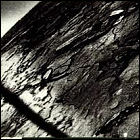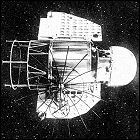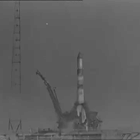Venera 14 lands on Venus
 The Soviet Union’s unmanned Venera 14 space probe successfully lands on the planet Venus, its landing module enduring almost an hour in temperatures of nearly 900 degrees Fahrenheit and air pressure nearly 100 times that experienced at sea level on Earth. A soil sampling experiment is thwarted by an unforseen problem, namely the lens cap of Venera 14’s camera popping off and landing precisely where its sampling arm was designed to gather Venusian soil for testing.
The Soviet Union’s unmanned Venera 14 space probe successfully lands on the planet Venus, its landing module enduring almost an hour in temperatures of nearly 900 degrees Fahrenheit and air pressure nearly 100 times that experienced at sea level on Earth. A soil sampling experiment is thwarted by an unforseen problem, namely the lens cap of Venera 14’s camera popping off and landing precisely where its sampling arm was designed to gather Venusian soil for testing.
Venera 10 lands on Venus
 Launched less than a week after history-making sister ship Venera 9, the unmanned Soviet space probe Venera 10 lands on Venus mere days after its twin, and experiences similar system failures due to the harsh environment on the planet. Venera 10’s landing site – captured in a single picture – shows strong evidence of past lava flows.
Launched less than a week after history-making sister ship Venera 9, the unmanned Soviet space probe Venera 10 lands on Venus mere days after its twin, and experiences similar system failures due to the harsh environment on the planet. Venera 10’s landing site – captured in a single picture – shows strong evidence of past lava flows.
Venera 9: first pictures from another planet
 The Soviet Venera 9 unmanned space probe touches down on the surface of Venus, the first spacecraft to soft-land on another planet and send back pictures. With atmospheric pressure measured at almost 100 times Earth sea level pressure, and temperatures over 900 degrees Fahrenheit, Venera 9 manages to stay intact for barely an hour, sending back a single panoramic picture of Venus before the environment overcomes its systems.
The Soviet Venera 9 unmanned space probe touches down on the surface of Venus, the first spacecraft to soft-land on another planet and send back pictures. With atmospheric pressure measured at almost 100 times Earth sea level pressure, and temperatures over 900 degrees Fahrenheit, Venera 9 manages to stay intact for barely an hour, sending back a single panoramic picture of Venus before the environment overcomes its systems.
Venera 4
 The Soviet Union launches Venera 4, a space probe dispatched to the planet Venus. Venera 4 is equipped with a landing probe which it deposits into the planet’s dense atmosphere in October, and the probe’s findings stun scientists on Earth who had long considered Venus a near-twin of Earth: the atmosphere is predominantly carbon dioxide, with minimal oxygen and a pressure nearly 100 times Earth’s atmospheric pressure at sea level. The temperature within the Venusian atmosphere is found to soar past 800 degrees Fahrenheit, presenting a challenge for designers of the next round of vehicles to visit the planet. The Venera 4 landing probe is not equipped with cameras, and contact is lost with it before contact is made with the ground.
The Soviet Union launches Venera 4, a space probe dispatched to the planet Venus. Venera 4 is equipped with a landing probe which it deposits into the planet’s dense atmosphere in October, and the probe’s findings stun scientists on Earth who had long considered Venus a near-twin of Earth: the atmosphere is predominantly carbon dioxide, with minimal oxygen and a pressure nearly 100 times Earth’s atmospheric pressure at sea level. The temperature within the Venusian atmosphere is found to soar past 800 degrees Fahrenheit, presenting a challenge for designers of the next round of vehicles to visit the planet. The Venera 4 landing probe is not equipped with cameras, and contact is lost with it before contact is made with the ground.
Venera 3
 The Soviet Union launches Venera 3, its third attempt to send a spacecraft to Venus. Intended to land on the surface of what is still thought of as a near-twin of Earth, Venera 3’s landing capsule does indeed enter the Venusian atmosphere in March 1966, though the capsule loses contact with Earth and goes silent before ever hitting the surface of Venus. Venera 3 may be the first human-made object ever to arrive on another planet, but no telemetry exists to prove that it arrived in one piece.
The Soviet Union launches Venera 3, its third attempt to send a spacecraft to Venus. Intended to land on the surface of what is still thought of as a near-twin of Earth, Venera 3’s landing capsule does indeed enter the Venusian atmosphere in March 1966, though the capsule loses contact with Earth and goes silent before ever hitting the surface of Venus. Venera 3 may be the first human-made object ever to arrive on another planet, but no telemetry exists to prove that it arrived in one piece.
Venera 2
 The Soviet Venera 2 space probe is launched toward Venus, and for the first time cameras are placed aboard a vehicle bound for that planet. Venera 2 will eventually pass within 14,000 miles of its target, but electrical failures silence the space probe and its instruments long before the flyby.
The Soviet Venera 2 space probe is launched toward Venus, and for the first time cameras are placed aboard a vehicle bound for that planet. Venera 2 will eventually pass within 14,000 miles of its target, but electrical failures silence the space probe and its instruments long before the flyby.
Venera 1
 The Soviet Union launches Venera 1, the first interplanetary space probe. Bound for Venus, Venera 1 returns measurements and observations taken during its three-month flight, but loses contact with ground controllers just as it makes its closest approach to Venus at a distance of 62,000 miles from the planet. It falls into an orbit around the sun after falling silent.
The Soviet Union launches Venera 1, the first interplanetary space probe. Bound for Venus, Venera 1 returns measurements and observations taken during its three-month flight, but loses contact with ground controllers just as it makes its closest approach to Venus at a distance of 62,000 miles from the planet. It falls into an orbit around the sun after falling silent.